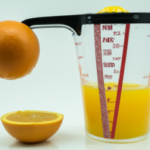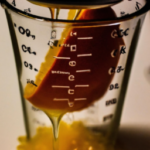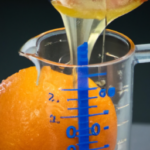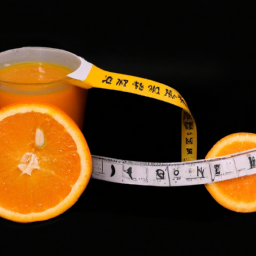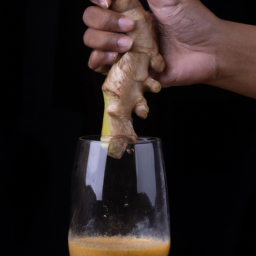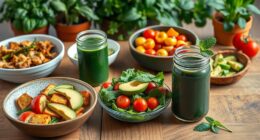As a child, I was fascinated by the magic of squeezing juice from an orange. It seemed so simple, yet the amount of juice that came out always felt like a mystery.
Now, as an adult, I understand the importance of knowing how much juice is in one orange, not just for satisfying my curiosity, but for health and nutritional reasons as well.
The amount of juice in one orange can vary greatly depending on a variety of factors, such as the type of orange, its ripeness, and even the time of year. Understanding these factors and how to measure orange juice accurately can help us make informed decisions about our diets and ensure we are getting the right amount of essential nutrients.
In this article, we will explore the importance of knowing the amount of orange juice, the factors that affect it, and the nutritional value and health benefits of drinking orange juice.
Key Takeaways
- The amount of juice in an orange can be affected by factors like type, ripeness, and juicing method.
- Measuring accurately is important for recipes and daily consumption, and using a kitchen scale can provide precise measurements for extracting the optimal amount of juice.
- Consuming too much orange juice can have drawbacks, such as increased sugar intake, tooth decay, weight gain, and acid reflux.
- Orange juice is a good source of vitamin C, potassium, folate, and thiamine, but it’s important to exercise caution when drinking it if you are allergic to citrus fruits.
The Importance of Knowing the Amount of Orange Juice
You gotta know how much orange juice you’re getting from one fruit, it can make all the difference in your recipe or morning routine. Orange juice is not only delicious, but it’s also packed with vitamins and minerals that are essential for good health. That’s why it’s important to know how much juice you’re getting from one orange to ensure that you’re getting the most out of this nutritious fruit.
The role of orange juice in a balanced diet cannot be overstated. It’s a great source of vitamin C, which is important for a strong immune system and healthy skin. Juicing vs. consuming whole oranges for optimal health is a topic of debate among health experts. While juicing can provide a concentrated dose of vitamins and minerals, consuming whole oranges provides fiber, which is important for digestive health.
Knowing how much juice you’re getting from one orange can help you make informed decisions about how to incorporate this fruit into your diet. Factors affecting the amount of juice in an orange include the variety of orange, its ripeness, and the juicing method used. By understanding these factors, you can get the most out of your oranges and enjoy their delicious and nutritious juice.
Factors Affecting the Amount of Juice in an Orange
When it comes to extracting juice from an orange, there are several factors that can affect the amount of juice you get. Based on my experience, the size of the orange is one key factor.
Generally, larger oranges tend to yield more juice than smaller ones. Another important factor is the ripeness of the orange. Ripe oranges tend to be juicier than unripe ones.
Lastly, the method of extraction can also impact the amount of juice you get. Squeezing the orange by hand may result in less juice compared to using an electric juicer.
Size of the Orange
As I hold the orange in my hand, I can’t help but wonder how much juice it will yield. The size of the orange is a major factor that affects the amount of juice that can be extracted from it.
There are various orange varieties, and some are naturally larger than others. Therefore, if you’re looking to extract a lot of juice from an orange, it’s best to choose a bigger one. Juicing techniques also play a role in how much juice can be extracted from an orange.
Squeezing an orange by hand may not yield as much juice as using a juicer. A juicer can extract the juice from the orange more efficiently, resulting in a greater yield. However, it’s important to note that the size of the orange still matters when using a juicer.
As we move on to the next subtopic, we’ll discuss how the ripeness of the orange affects the amount of juice that can be extracted.
Ripeness of the Orange
The ripeness of an orange can greatly impact the flavor and overall quality of its juice. As oranges mature, their sugar content increases, which is essential for a sweeter and tastier juice. However, if an orange is overripe, its juice may become overly bitter and less palatable. Therefore, it is important to consider the ripeness of the orange before juicing it.
To help illustrate the impact of orange ripeness on juice quality, here is a table comparing the sugar content of oranges at different stages of ripeness:
| Ripeness Level | Sugar Content (grams per 100 ml) |
|---|---|
| Unripe | 7.5 |
| Semi-ripe | 9.0 |
| Ripe | 10.5 |
| Overripe | 9.0 |
As you can see, there is a significant increase in sugar content as oranges mature from unripe to ripe. However, if the orange becomes overripe, the sugar content drops back down to semi-ripe levels, and the juice may become bitter. Therefore, it is important to use oranges that are at the peak of their ripeness for the best juice extraction results. In the next section, we will discuss different methods of extracting juice from oranges.
Method of Extraction
To get the most out of a ripe orange, it’s important to know which method of extraction will yield the most flavorful and delicious juice. There are several juice extraction techniques that can be used, but the most common are hand squeezing and using citrus juicing tools.
Hand squeezing can be done by simply using your hands to squeeze the orange until all the juice is extracted. On the other hand, using citrus juicing tools such as a manual or electric juicer can make the process faster and more efficient. Some popular citrus juicing tools include a hand-held reamer, a citrus press, and a centrifugal juicer. Each tool has its own pros and cons, but they all aim to extract the maximum amount of juice from the orange.
When it comes to measuring orange juice, there are several ways to do this accurately. One method is to use a measuring cup and pour the juice into it. Another method is to use a kitchen scale and weigh the juice.
Regardless of the method used, it’s important to know how much juice is extracted from one orange in order to accurately measure the amount needed for recipes or daily consumption.
How to Measure Orange Juice
When it comes to measuring orange juice, there are a few methods that I find useful. Firstly, a measuring cup is a simple and effective way to measure the amount of juice squeezed from an orange.
Secondly, using a juicer or reamer can also be useful, as it allows for more precise measurements.
Finally, for those who prefer to measure by weight, a kitchen scale can be used to accurately measure the amount of juice obtained from an orange.
Using a Measuring Cup
Measuring orange juice is like a puzzle; you have to fit the pieces of the fruit together perfectly to get the right amount. To do so, using a measuring cup is the most accurate way. Here are four tips to increase measuring accuracy and adjust for pulp:
-
Use a clear measuring cup: This will make it easy to see the juice level and ensure you have the correct amount.
-
Stir the juice: Before measuring, stir the juice to distribute the pulp evenly. This’ll help you get a more accurate measurement.
-
Adjust for pulp: If you prefer pulp-free juice, strain the juice through a fine mesh sieve or cheesecloth before measuring. Alternatively, if you prefer pulp, add an extra tablespoon or two to your measurement.
-
Measure at eye level: To ensure an accurate measurement, hold the measuring cup at eye level to make sure the juice is at the correct line.
Using a juicer or reamer is another option for getting juice from an orange. However, it can be difficult to get an exact measurement this way. Nevertheless, using a juicer or reamer can be a great way to get fresh juice quickly and easily.
Using a Juicer or Reamer
Moving on from using a measuring cup, another way to extract juice from an orange is by using a juicer or reamer. Both tools are designed to make the process of juicing easier and more efficient. However, which one is more efficient depends on personal preference and the amount of juice needed.
A juicer is a tool that extracts juice from fruits and vegetables by crushing and separating the pulp from the juice. It is a great option for those who need to juice a large amount of oranges or other fruits. On the other hand, a reamer is a handheld tool that is used to manually extract juice from fruits. It is a more affordable option and is ideal for juicing small amounts of citrus fruits. To choose the right juicing tool for your needs, consider how often you will be juicing and how much juice you need. If you plan to juice frequently or in large quantities, a juicer may be the better option. However, if you only need to juice occasionally or in small amounts, a reamer may be a more practical choice.
When it comes to juicing, having the right tool can make all the difference. Whether you choose a juicer or a reamer, both tools will help you extract juice from oranges and other citrus fruits. To ensure the best results, it is important to choose the right tool for your needs. In the next section, we will explore another method for measuring the juice of an orange using a kitchen scale.
Using a Kitchen Scale
Using a kitchen scale can provide precise measurements for extracting the optimal amount of juice from an orange, ensuring that every recipe turns out perfectly. Measuring precision is crucial when it comes to cooking or baking, and using a kitchen scale can help achieve that.
By weighing the orange before and after juicing, one can calculate the exact amount of juice extracted. This eliminates any guesswork and ensures that the recipe is not compromised due to inaccurate measurements. Unit conversion can also be easily done with a kitchen scale, as it allows for measuring in both grams and ounces.
This is particularly helpful when following recipes from different countries or regions that use different units of measurement. By using a kitchen scale, one can easily convert the weight of the orange to the desired unit, making it easier to follow the recipe accurately.
Overall, using a kitchen scale is a practical and reliable method of extracting the optimal amount of juice from an orange for any recipe. Moving on to the next section about the nutritional value of orange juice, it’s important to note that the amount of juice extracted can affect the nutritional value of the final product.
Nutritional Value of Orange Juice
When I think about orange juice, I’m immediately reminded of its high Vitamin C content, which is essential for healthy skin, bones, and immune system.
But did you know that orange juice also contains other important nutrients, such as potassium, folate, and thiamine?
It’s important to note that while orange juice can be a great source of nutrients, it’s also high in calories, so it’s essential to monitor your intake if you’re watching your weight.
Vitamin C Content
Pssst, did you know that the juicy goodness of one orange contains a hefty dose of vitamin C? This essential nutrient is responsible for a variety of benefits, including boosting the immune system, protecting against chronic disease, and promoting skin health. The recommended daily intake of vitamin C for adults is 75-90 milligrams, and just one medium-sized orange can provide up to 70% of that amount!
If you’re looking to up your vitamin C intake, consider adding oranges to your diet. Here are some fun and tasty ways to enjoy this nutritious fruit:
- Squeeze fresh orange juice to enjoy as a refreshing drink or to use in smoothies.
- Add orange slices to a salad for a burst of citrus flavor.
- Use orange zest to add flavor to baked goods or marinades.
- Make a homemade orange vinaigrette for a healthy and flavorful salad dressing.
While vitamin C is certainly a standout nutrient in oranges, they also contain a variety of other important vitamins and minerals.
Let’s take a closer look at the nutritional profile of this delicious fruit.
Other Nutrients
Moving on from the previous subtopic of Vitamin C content in orange juice, it’s important to note that oranges contain other nutrients as well. In fact, a single orange provides a range of essential vitamins and minerals that are beneficial for overall health.
Some of the other nutrients found in oranges include folate, potassium, and thiamine. Folate is important for cell growth and development, while potassium is essential for maintaining healthy blood pressure levels. Thiamine, on the other hand, is important for energy production and cognitive function. However, it’s important to note that consuming too much orange juice can also have drawbacks, such as increased sugar intake. Therefore, it’s recommended to consume orange juice in moderation and to balance it with other nutrient-dense foods.
| Nutrient | Amount per Orange |
|---|---|
| Vitamin C | 70 mg |
| Folate | 39 mcg |
| Potassium | 252 mg |
| Thiamine | 0.1 mg |
| Calories | 62 |
Overall, incorporating oranges into your diet can provide numerous benefits. However, it’s important to be mindful of recommended intake and to balance it with other healthy foods. With that being said, let’s now transition into discussing caloric intake and how it relates to orange juice consumption.
Caloric Intake
To really understand the impact of consuming oranges, you should pay close attention to your caloric intake. One medium-sized orange contains about 60 calories, which is relatively low. However, if you juice the orange, you may be consuming more calories than you realize.
The juice of one orange contains about 50-60 calories, depending on the size of the orange and how much pulp it contains. This may not seem like a lot, but if you are consuming several glasses of juice per day, those calories can add up quickly.
When it comes to weight management, it’s generally better to eat oranges rather than juice them. This is because the fiber in the whole fruit can help to keep you feeling full and satisfied, which can help to prevent overeating. Additionally, the act of chewing and digesting whole fruit requires more energy than simply drinking juice. However, if you do prefer to drink juice, try to limit your intake and choose a juice that’s 100% pure, without any added sugars or preservatives.
While caloric intake is an important consideration, it’s also important to remember that oranges and their juice offer a wide range of health benefits.
Health Benefits of Drinking Orange Juice
Drinking orange juice, with its high levels of vitamin C and antioxidants, can offer numerous health benefits. Here are four reasons why you should consider adding a glass of orange juice to your daily routine:
-
Boosts immune system: Vitamin C, found in high amounts in orange juice, helps strengthen the immune system and reduce the risk of infections and illnesses.
-
Improves digestion: Orange juice contains fiber and natural sugars that aid in digestion and regulate bowel movements.
-
Lowers cholesterol: Drinking orange juice can help lower LDL cholesterol levels, thanks to the flavonoids found in the fruit.
-
Protects against diseases: The antioxidants in orange juice can help protect against chronic diseases such as cancer, heart disease, and Alzheimer’s.
When juicing oranges, there are various techniques and flavor variations to consider. Some juicers prefer to use a hand-held citrus press, while others opt for an electric juicer. Additionally, some people enjoy adding other fruits or vegetables to their orange juice for added flavor and nutrients.
However, it’s important to note that consuming too much orange juice can have negative effects. This includes an increased risk of tooth decay and weight gain. In the next section, we will discuss the risks and precautions associated with drinking orange juice.
Risks and Precautions
As I delve into the risks and precautions associated with drinking orange juice, I can’t ignore its high sugar content. This can cause blood sugar spikes and negatively impact dental health.
Additionally, the acidic nature of orange juice can cause acid reflux and worsen symptoms of GERD.
Lastly, those with allergies to citrus fruits should exercise caution. Drinking orange juice can trigger allergic reactions.
Sugar Content
You can’t deny that the sugar content in a single orange can be compared to a teaspoon of sugar – it may not seem like much, but it can add up quickly if you’re drinking multiple glasses a day. This is especially important to consider for individuals who are trying to watch their sugar intake, such as those with diabetes or those who are trying to maintain a healthy weight. While the sugar in oranges is natural and comes with important nutrients, such as vitamin C, it still has the potential to affect our bodies in various ways.
To better understand the sugar content in orange juice, let’s take a look at a comparison table of various fruit juices. As you can see in the table below, orange juice ranks high in terms of sugar content, even when compared to other fruit juices. This is something to keep in mind when considering how much orange juice to consume in a day, and possibly opting for lower-sugar options, such as grapefruit juice or cranberry juice. Moving on to the next section, let’s explore the acidic nature of orange juice and its effects on our bodies.
| Juice Type | Serving Size (8 oz) | Grams of Sugar |
|---|---|---|
| Orange | 1 cup (8 oz) | 21g |
| Apple | 1 cup (8 oz) | 24g |
| Grapefruit | 1 cup (8 oz) | 9g |
| Cranberry | 1 cup (8 oz) | 30g |
| Pineapple | 1 cup (8 oz) | 25g |
As we move into the next section about the acidic nature of orange juice, it is important to understand how this acidity can affect our bodies.
Acidic Nature
If you consume acidic foods and beverages regularly, your body may become more susceptible to inflammation and digestive discomfort. However, there are also benefits to consuming acidic foods.
The acidic nature of some fruits, such as oranges, can help stimulate the production of digestive enzymes in the stomach, aiding in the breakdown of food and absorption of nutrients. Additionally, the acidity in fruits like oranges can help inhibit the growth of harmful bacteria in the gut, promoting a healthy microbiome.
Despite these benefits, it’s important to be mindful of the effects of acidic nature on digestion. Consuming too much acidic food can lead to acid reflux, heartburn, and other digestive issues. It’s important to maintain a balanced diet and consume acidic foods in moderation, especially if you have pre-existing digestive issues.
With that said, let’s now move on to discussing the topic of allergies.
Allergies
When allergies strike, your body’s immune system overreacts to a usually harmless substance. Managing allergies can be a challenge, as symptoms can range from mild to severe. It is important to identify the allergen and avoid exposure, but this isn’t always possible.
In such cases, medications such as antihistamines, decongestants, and nasal corticosteroids can be helpful, but they come with potential side effects like drowsiness, dry mouth, and increased heart rate.
Another way to manage allergies is to boost your immune system with vitamins and minerals. Vitamin C, found in oranges and other citrus fruits, is known to have anti-inflammatory properties and can help reduce allergy symptoms. However, some people may have allergic reactions to oranges or other citrus fruits, and should avoid them altogether.
In such cases, alternative sources of vitamin C, such as strawberries, kiwis, and bell peppers, can be consumed instead.
Alternative Sources of Vitamin C
Looking for other ways to boost your vitamin C intake? It’s important to consider both natural vitamin C sources from foods and supplements. While supplements can be convenient, it’s important to note that natural sources of vitamin C are usually better absorbed by the body.
Additionally, natural sources are often more beneficial as they come with additional vitamins, minerals, and fiber that are important for overall health. Some great natural sources of vitamin C include strawberries, kiwis, and bell peppers. These foods are just as, if not more, vitamin C-rich than oranges. In fact, bell peppers have more vitamin C per serving than oranges!
Other vitamin C-rich foods include pineapple, guava, papaya, and broccoli. Incorporating these foods into your diet can help ensure that you’re getting enough of this important nutrient.
Looking for ways to use orange juice in your cooking? There are countless recipes that incorporate this citrusy flavor. From marinades to salad dressings to baked goods, orange juice can add a bright and refreshing twist to any dish. Try using it as a substitute for vinegar in your favorite vinaigrette recipe or mix it with honey and soy sauce for a delicious marinade for chicken or fish. The possibilities are endless!
Using Orange Juice in Recipes
Now that we’ve explored alternative sources of vitamin C, let’s talk about using orange juice in recipes. As someone who loves cooking and experimenting in the kitchen, I can attest that fresh orange juice can add a bright and refreshing flavor to many dishes.
From marinades to dressings to desserts, there are countless ways to incorporate this citrusy liquid into your meals. But orange juice isn’t just a delicious ingredient – it also has some surprising benefits for your skin. The vitamin C in orange juice can help to brighten and even out your complexion, while the antioxidants can protect against damage from free radicals.
So the next time you’re whipping up a recipe that calls for orange juice, don’t be afraid to give your skin a little extra love by incorporating it into your skincare routine as well.
Speaking of using fresh orange juice in recipes, it’s important to know how to store it properly to ensure it stays fresh and flavorful.
Storing Orange Juice
Properly storing fresh orange juice can prolong its shelf life and maintain its delicious tangy flavor, ensuring that it’s always on hand for your favorite recipes and skincare routines. The shelf life of orange juice depends on several factors such as the method of extraction, storage temperature, and exposure to light and air.
To extend the shelf life of orange juice, it’s best to store it in a glass container with a tight-fitting lid, preferably in the refrigerator. Exposure to air can cause the juice to oxidize quickly, leading to a sour taste and loss of nutrients.
It’s also important to avoid storing the juice near strong-smelling foods as the juice can easily absorb unwanted odors. By following these simple storage guidelines, you can enjoy fresh and tangy orange juice for up to a week.
Frequently Asked Questions
How many calories are in one serving of orange juice?
I can confirm that one serving of orange juice contains approximately 112 calories. Additionally, orange juice is a good source of vitamin C, folate, and potassium, making it a nutritious addition to any diet.
Can you substitute orange juice for lemon juice in a recipe?
While substituting citrus fruits in recipes is possible, it may require recipe adjustments. For example, swapping orange juice for lemon juice can alter the flavor profile and acidity level. It’s important to experiment and adjust accordingly.
How long does it take for an orange to produce juice after being squeezed?
Juice extraction techniques and factors affecting orange juice yield determine the time it takes for an orange to produce juice after being squeezed. The process can take a few minutes to several hours, depending on these factors.
What are some common additives in store-bought orange juice?
As a nutritionist, I can tell you that store-bought orange juice often contains additives like high fructose corn syrup, artificial flavors, and preservatives. While convenient, these additives can diminish the nutritional value of the juice.
How does the amount of juice in an orange vary by season or variety?
I have observed that the juice yield of an orange varies by season and variety. Seasonal variation affects the size and water content of the fruit, which in turn affects the amount of juice extracted.
Conclusion
In conclusion, knowing the amount of juice in one orange is crucial for many reasons. It helps in determining the right amount of oranges needed for a recipe or for daily consumption. Factors such as the orange variety, ripeness, and juicing method affect the amount of juice obtained. Measuring orange juice is simple and can be done using a measuring cup or a juicer.
Drinking orange juice provides numerous health benefits, including boosting the immune system and reducing the risk of chronic diseases. However, it’s important to consume in moderation and be aware of its high sugar content. For instance, a hypothetical example of a person who drinks too much orange juice and develops diabetes could emphasize the importance of moderation.
In addition, alternative sources of vitamin C and storing orange juice can be explored to ensure consumption of fresh and healthy juice. Overall, understanding the amount and benefits of orange juice can lead to a healthier lifestyle.
Ilana has been a vegan for over 10 years. She originally made the switch for health reasons, but soon found herself becoming more and more passionate about the ethical and environmental implications of a vegan lifestyle. Ilana is the author of The Graceful Kitchen, a blog all about veganism. She loves to cook up delicious and nutritious vegan meals, and share her recipes with others who are interested in leading a cruelty-free life. Ilana is also a strong advocate for using whole foods as the foundation of a healthy diet, and believes that going vegan is one of the best ways to achieve this.




